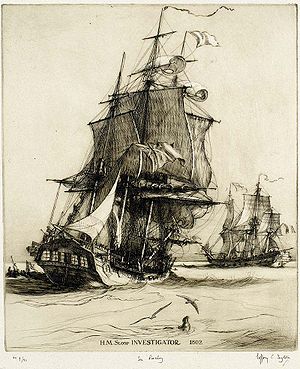HMS Investigator (1798)

20th century drawing of Investigator.
|
|
| History | |
|---|---|
|
|
|
| Name: | Fram |
| Builder: | Unknown, at Monkwearmouth, Sunderland |
| Launched: | 1795 |
| Fate: | Sold 1798 |
| Notes: | Collier |
|
|
|
| Name: | HMS Xenophon |
| Acquired: | 1798 |
| Renamed: | HMS Investigator (1801) |
| Fate: | Sold 1810 |
|
|
|
| Name: | Xenophon |
| Acquired: | 1810 by purchase |
| Fate: | Broken up about 1872 |
| General characteristics | |
| Tons burthen: |
|
| Length: |
|
| Beam: |
|
| Draught: | 15 ft (4.6 m) |
| Depth of hold: |
|
| Propulsion: | Sails |
| Sail plan: | Sloop |
| Complement: | 80 |
| Armament: |
|
HMS Investigator was the mercantile Fram, launched in 1795, which the Royal Navy purchased in 1798 and renamed HMS Xenophon, and then in 1801 converted to a survey ship under the name HMS Investigator. In 1802, under the command of Matthew Flinders, she was the first ship to circumnavigate Australia. The Navy sold her in 1810 and she returned to mercantile service under the name Xenophon. She was probably broken up c.1872.
Fram was built in Sunderland as a collier. She operated off the north-east coast of England before the Royal Navy purchased her in 1798. Pitcher, of Northfield refitted her between 27 April and 24 May 1798. She then went to Deptford Dockyard on 6 August. The Navy armed her with 22 carronades to serve as an escort vessel, and renamed her HMS Xenophon.
Commander George Sayer commissioned Xenophon as an armed ship for the North Sea. In 1799 he brought the Irish rebel James Napper Tandy and some of his associates as state prisoners from Hamburg to England. Around February 1800 Sayer removed to HMS Inspector.
At the urging of the naturalist Sir Joseph Banks, the Admiralty decided to launch an expedition to map the Australian coastline, as well as further study the plant and animal life on the new colony. Attached to the expedition was the botanist Robert Brown,the botanical artist Ferdinand Bauer and the landscape artist William Westall. The Admiralty chose Xenophon for the expedition: her former mercantile role meant that she had a small draught and ample space for supplies, making her particularly suitable for a long exploratory voyage. On the other hand, she was in relatively poor condition, and could therefore be spared from service in the war against France.
...
Wikipedia
